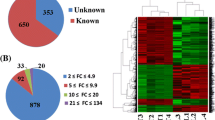Abstract
Objective
Conversion of androstenedione to testosterone, the most potent androgen secreted by the ovary, is carried out by androgenic 17β-hydroxysteroid dehydrogenase (17β-HSD) activity. The molecular basis for this is unclear. We tested the hypothesis that type 5 17β-HSD (17β-HSD5) is responsible for testosterone formation from androstenedione in the human ovary.
Methods
We used primers specific for each type of 17β-HSD to identify quantitatively and directly sequence the polymerase chain reaction products of a human ovary library.
Results
17β-HSD1, 17β-HSD4, and 17β-HSD5 were detected in the library lysate, but not 17β-HSD2 or 17β-HSD3. 17β-HSD5 was the predominant androgenic form of 17β-HSD expressed in human ovary.
Conclusion
These data suggest that 17β-HSD5 may play a major role in testosterone biosynthesis by the human ovary. Further investigation of the regulation of 17β-HSD5 gene expression is warranted with regard to ovarian testosterone secretion in normal and abnormal states of ovarian function, such as polycystic ovary syndrome.
Similar content being viewed by others
References
Labrie F, Luu-The V, Lin SX, et al. The key role of 17 beta-hydroxysteroid dehydrogenases in sex steroid biology. Steroids 1997;62:148–58.
Peltoketo H, Isomaa V, Maentausta O, et al. Complete amino acid sequence of human placental 17 beta-hydroxysteroid dehydrogenase deduced from cDNA. FEBS Lett 1988;239:73–7.
The VL, Labrie C, Zhao MF, et al. Characterization of cDNAs for human estradiol 17 beta-dehydrogenase and assignment of the gene to chromosome 17: Evidence of two mRNA species with distinct 5′-termini in human placenta. Mol Endocrinol 1989;3:1301–9.
Wu L, Einstein M, Geissler WM, et al. Expression cloning and characterization of human 17 beta-hydroxysteroid dehydrogenase type 2, a microsomal enzyme possessing 20 alpha-hydroxysteroid dehydrogenase activity. J Biol Chem 1993;268:12964–9.
Casey ML, MacDonald PC, Andersson S. 17 beta-Hydroxy-steroid dehydrogenase type 2: Chromosomal assignment and progestin regulation of gene expression in human endometrium. J Clin Invest 1994;94:2135–41.
Mendonca B, Arnhold I, Bloise W, et al. 17β-Hydroxysteroid dehydrogenase 3 deficiency in women. J Clin Endocrinol Metab 1999;84:802–4.
Geissler WM, Davis DL, Wu L, et al. Male pseudohermaphroditism caused by mutations of testicular 17 beta-hydroxysteroid dehydrogenase 3. Nat Genet 1994;7:34–9.
Stoffel-Wagner B, Watzka M, Steckelbroeck S, et al. Expression of 17 beta-hydroxysteroid dehydrogenase types 1, 2, 3 and 4 in the human temporal lobe. J Endocrinol 1999;160:119–26.
Zhang Y, Word RA, Fesmire S, et al. Human ovarian expression of 17 beta-hydroxysteroid dehydrogenase types 1,2, and 3. J Clin Endocrinol Metab 1996;81:3594–8.
Adamski J, Normand T, Leenders F, et al. Molecular cloning of a novel widely expressed human 80 kDa 17 beta-hydroxysteroid dehydrogenase IV. Biochem J 1995;311:437–43.
Dufort I, Rheault P, Huang XF, et al. Characteristics of a highly labile human type 5 17 beta-hydroxysteroid dehydrogenase. Endocrinology 1999;140:568–74.
Khanna M, Qin K, Wang RW, et al. Substrate specificity, gene structure, and tissue-specific distribution of multiple human 3 alpha-hydroxysteroid dehydrogenases. J Biol Chem 1995;270:20162–8.
Lin HK, Jez JM, Schlegel BP, et al. Expression and characterization of recombinant type 2 3 alpha-hydroxysteroid dehydrogenase (HSD) from human prostate: Demonstration of bifunctional 3 alpha/17 beta-HSD activity and cellular distribution. Mol Endocrinol 1997;11:1971–84.
Qin K, New MI, Cheng KC. Molecular cloning of multiple cDNAs encoding human enzymes structurally related to 3 alpha-hydroxysteroid dehydrogenase. J Steroid Biochem Mol Biol 1993;46:673–9.
Qin K, Khanna M, Cheng KC. Structure of a gene coding for human dihydrodiol dehydrogenase/bile acid-binding protein. Gene 1994;149:357–61.
Adashi EY, Hennebold JD. Single-gene mutations resulting in reproductive dysfunction in women. N Engl J Med 1999;340:709–18.
Harada N, Utsumi T, Takagi Y. Tissue-specific expression of the human aromatase cytochrome P-450 gene by alternative use of multiple exons 1 and promoters, and switching of tissue-specific exons 1 in carcinogenesis. Proc Natl Acad Sci USA 1993;90:11312–6.
Horton R, Tait JF. Androstenedione production and interconversion rates measured in peripheral blood and studies on the possible site of its conversion to testosterone. J Clin Invest 1966;45:301–13.
Bardin C, Lipsett M. Testosterone and androstenedione blood production rates in normal women and women with idiopathic hirsutism or polycystic ovaries. J Clin Invest 1967;46:891–902.
Kirschner MA, Sinhamahapatra S, Zucker IR, et al. The production, origin and role of dehydroepiandrosterone and D5-androstenediol as androgen prehormones in hirsute women. J Clin Endocrinol Metab 1973;37:183–9.
Ehrmann DA, Barnes RB, Rosenfield RL. Polycystic ovary syndrome as a form of functional ovarian hyperandrogenism due to dysregulation of androgen secretion. Endocr Rev 1995;16:322–53.
Rosenfield RL, Barnes RB, Ehrmann DA. Studies of the nature of 17-hydroxyprogesterone hyperresponsiveness to gonadotropin releasing hormone agonist challenge in functional ovarian hypcrandrogenism. J Clin Endocrinol Metab 1994;79:1686–92.
Pittaway DE, Andersen RN, Coleman SA Jr, et al. Human ovarian 17 beta-hydroxysteroid oxidoreductase activity: A comparison of normal and polycystic ovarian tissues. J Clin Endocrinol Metab 1983;56:715–29.
Barbieri R. Human ovarian 17-ketosteroid oxidoreductase: Unique characteristics of the granulosa-luteal cell and stromal enzyme. Am J Obstet Gynecol 1992;166:1117–23.
Author information
Authors and Affiliations
Corresponding author
Additional information
This work was supported by USPHS grant no. T32 DK-07011, a gift from Lilly Research Laboratories (KQ), and USPHS grant nos. HD-06308 and RR-00055 (RLR).
The authors thank Dr. Samuel Refetoff for helpful advice.
Rights and permissions
About this article
Cite this article
Qin, Kn., Rosenfield, R.L. Expression of 17β-Hydroxysteroid Dehydrogenase Type 5 in Human Ovary: A Pilot Study. Reprod. Sci. 7, 61–64 (2000). https://doi.org/10.1177/107155760000700109
Published:
Issue Date:
DOI: https://doi.org/10.1177/107155760000700109




